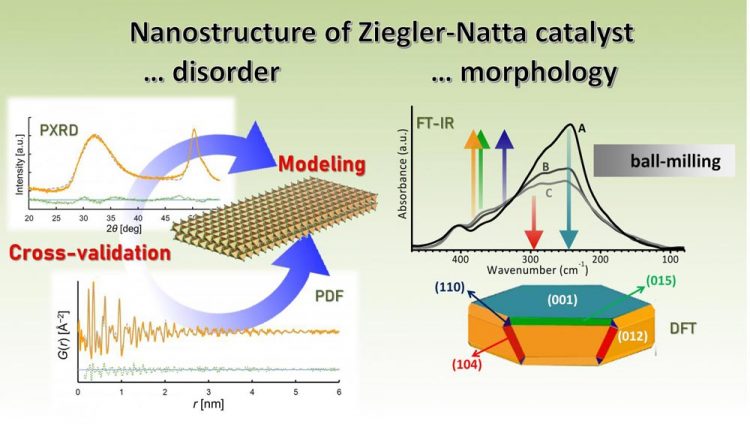Elucidation of nanostructures in practical heterogeneous catalysts

The nanostructure of the heterogeneous Ziegler-Natta catalyst was clarified on the basis of cutting-edge analytical techniques. Left: Typical synchrotron data and the determined nanoparticle model of the catalyst primary particle. Right: Experimental Far-IR spectra of a series of catalyst supports, and Wulff's polyhedra derived on the basis of surface formation energy. Credit: JAIST
Scientists from Japan Advanced Institute of Science and Technology (JAIST) and University of Torino (UNITO) have cooperatively clarified the nanostructure of the heterogeneous Ziegler-Natta catalyst by means of combined synchrotron X-ray analytical techniques, vibrational spectrocopies, and molecular simulations.
Understanding the structure and the working principle of practical catalysts is largely beneficial for designing catalysts towards desired performances.
However, this is often infeasible due to inherent complexity of such catalysts. The Ziegler-Natta catalyst is one of the most sophisticated practical catalysts for its performance in producing desired polyolefins at extremely high yield.
Nonetheless, the structure of the nanosized building unit of this catalyst has not been fully understood over six decades.
The collaborative research teams of Japan and Italy quantitatively determined the structural disorder and the dimensions of the building unit based on synchrotron X-ray total scattering analysis aided with molecular simulations.
Further, by combining infrared spectroscopies with state-of-the-art DFT simulations, the morphology and the surface exposure of the building unit were clarified.
The current research corresponds to the first attempt of adopting synchrotron X-ray total scattering and Far IR spectroscopy for the study of the Ziegler-Natta catalyst. Such the multi-faced approach successfully shed new light on the full elucidation of the nanostructure in practical heterogeneous catalysts.
###
Papers titled “Revisiting the identity of δ-MgCl2: Part I. Structural disorder studied by synchrotron X-ray total scattering”, and “Revisiting the identity of δ-MgCl2: Part II. Morphology and exposed surfaces studied by vibrational spectroscopies and DFT calculation”, both published in Journal of Catalysis, DOI: https:/
This research forms part of the research programme of DPI (P.O. Box 902, 5600 AX Eindhoven, the Netherlands), project #802.
Media Contact
More Information:
http://dx.doi.org/10.1016/j.jcat.2020.03.002All latest news from the category: Physics and Astronomy
This area deals with the fundamental laws and building blocks of nature and how they interact, the properties and the behavior of matter, and research into space and time and their structures.
innovations-report provides in-depth reports and articles on subjects such as astrophysics, laser technologies, nuclear, quantum, particle and solid-state physics, nanotechnologies, planetary research and findings (Mars, Venus) and developments related to the Hubble Telescope.
Newest articles

Sea slugs inspire highly stretchable biomedical sensor
USC Viterbi School of Engineering researcher Hangbo Zhao presents findings on highly stretchable and customizable microneedles for application in fields including neuroscience, tissue engineering, and wearable bioelectronics. The revolution in…

Twisting and binding matter waves with photons in a cavity
Precisely measuring the energy states of individual atoms has been a historical challenge for physicists due to atomic recoil. When an atom interacts with a photon, the atom “recoils” in…

Nanotubes, nanoparticles, and antibodies detect tiny amounts of fentanyl
New sensor is six orders of magnitude more sensitive than the next best thing. A research team at Pitt led by Alexander Star, a chemistry professor in the Kenneth P. Dietrich…





















